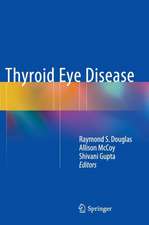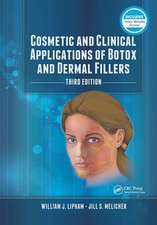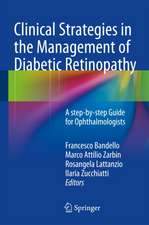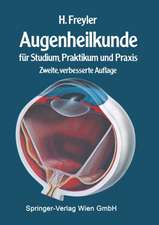Fifth International Visual Field Symposium: Sacramento, October 20–23, 1982: Documenta Ophthalmologica Proceedings Series, cartea 35
Editat de E.L. Greve, A. Heijlen Limba Engleză Paperback – 17 oct 2011
Din seria Documenta Ophthalmologica Proceedings Series
- 5%
 Preț: 358.48 lei
Preț: 358.48 lei - 5%
 Preț: 378.97 lei
Preț: 378.97 lei - 5%
 Preț: 1405.29 lei
Preț: 1405.29 lei - 5%
 Preț: 360.34 lei
Preț: 360.34 lei - 5%
 Preț: 375.34 lei
Preț: 375.34 lei - 5%
 Preț: 1427.79 lei
Preț: 1427.79 lei - 5%
 Preț: 372.03 lei
Preț: 372.03 lei - 5%
 Preț: 1419.39 lei
Preț: 1419.39 lei - 5%
 Preț: 1427.79 lei
Preț: 1427.79 lei - 5%
 Preț: 373.47 lei
Preț: 373.47 lei - 5%
 Preț: 379.89 lei
Preț: 379.89 lei - 5%
 Preț: 352.84 lei
Preț: 352.84 lei - 5%
 Preț: 366.35 lei
Preț: 366.35 lei - 5%
 Preț: 383.72 lei
Preț: 383.72 lei - 5%
 Preț: 1424.52 lei
Preț: 1424.52 lei - 5%
 Preț: 368.93 lei
Preț: 368.93 lei - 5%
 Preț: 713.33 lei
Preț: 713.33 lei - 5%
 Preț: 370.01 lei
Preț: 370.01 lei - 5%
 Preț: 374.41 lei
Preț: 374.41 lei - 5%
 Preț: 378.60 lei
Preț: 378.60 lei - 5%
 Preț: 367.28 lei
Preț: 367.28 lei - 5%
 Preț: 382.99 lei
Preț: 382.99 lei - 5%
 Preț: 370.38 lei
Preț: 370.38 lei - 5%
 Preț: 1417.54 lei
Preț: 1417.54 lei - 5%
 Preț: 2123.98 lei
Preț: 2123.98 lei - 5%
 Preț: 368.73 lei
Preț: 368.73 lei - 5%
 Preț: 2123.98 lei
Preț: 2123.98 lei - 5%
 Preț: 377.87 lei
Preț: 377.87 lei - 5%
 Preț: 1106.86 lei
Preț: 1106.86 lei - 5%
 Preț: 375.96 lei
Preț: 375.96 lei - 5%
 Preț: 380.97 lei
Preț: 380.97 lei - 5%
 Preț: 1417.54 lei
Preț: 1417.54 lei - 5%
 Preț: 376.87 lei
Preț: 376.87 lei - 5%
 Preț: 1104.48 lei
Preț: 1104.48 lei - 5%
 Preț: 1092.22 lei
Preț: 1092.22 lei - 5%
 Preț: 385.94 lei
Preț: 385.94 lei - 5%
 Preț: 373.68 lei
Preț: 373.68 lei - 5%
 Preț: 377.87 lei
Preț: 377.87 lei - 5%
 Preț: 375.70 lei
Preț: 375.70 lei - 5%
 Preț: 2123.06 lei
Preț: 2123.06 lei - 5%
 Preț: 370.74 lei
Preț: 370.74 lei - 5%
 Preț: 389.04 lei
Preț: 389.04 lei - 5%
 Preț: 2132.94 lei
Preț: 2132.94 lei - 5%
 Preț: 344.02 lei
Preț: 344.02 lei - 5%
 Preț: 385.94 lei
Preț: 385.94 lei - 5%
 Preț: 373.47 lei
Preț: 373.47 lei
Preț: 381.54 lei
Preț vechi: 401.61 lei
-5% Nou
Puncte Express: 572
Preț estimativ în valută:
73.01€ • 76.38$ • 60.65£
73.01€ • 76.38$ • 60.65£
Carte tipărită la comandă
Livrare economică 03-17 aprilie
Preluare comenzi: 021 569.72.76
Specificații
ISBN-13: 9789400972742
ISBN-10: 9400972741
Pagini: 528
Ilustrații: 516 p.
Dimensiuni: 155 x 235 x 28 mm
Greutate: 0.74 kg
Ediția:Softcover reprint of the original 1st ed. 1983
Editura: SPRINGER NETHERLANDS
Colecția Springer
Seria Documenta Ophthalmologica Proceedings Series
Locul publicării:Dordrecht, Netherlands
ISBN-10: 9400972741
Pagini: 528
Ilustrații: 516 p.
Dimensiuni: 155 x 235 x 28 mm
Greutate: 0.74 kg
Ediția:Softcover reprint of the original 1st ed. 1983
Editura: SPRINGER NETHERLANDS
Colecția Springer
Seria Documenta Ophthalmologica Proceedings Series
Locul publicării:Dordrecht, Netherlands
Public țintă
ResearchCuprins
Glaucoma: Correlation of disc, retinal nerve fiber layer and visual field.- Correlation of the peripapillary anatomy with the disc damage and field abnormalities in glaucoma.- The first observable glaucoma changes after an optic disc haemorrhage.- Correlation between computerized perimetry and retinal nerve fibre layer photography after optic disc haemorrhage.- Kinetic quantitative perimetry of retinal nerve fiber layer defects in glaucoma by fundus photo-perimeter.- The relation between excavation and visual field in glaucoma patients with high and with low intraocular pressures.- Computer-generated display for three-dimensional static perimetry: correlation of optic disc changes with glaucomatous defects.- Correlation between the stereographic shape of the ocular fundus and the visual field in glaucomatous eyes.- The relationship between a circumlinear vessel gap at the neuroretinal rim and glaucomatous visual field loss.- Fluorescein angiographic defects of the optic disc in glaucomatous visual field loss.- Capillary hyperpermeability of the optic disc and functional evolution in glaucoma.- Optic disc changes with the progression of glaucomatous visual field damage.- Optic disc analysis by computerized image subtraction and perimetry.- Discussions.- Glaucoma: Visual field and low-tension glaucoma.- A comparative study of visual fields of patients with low-tension glaucoma and those with chronic simple glaucoma.- Comparison of glaucomatous visual field defects in patients with high and with low intraocular pressures.- The visual field defects of low-tension glaucoma (A comparison of the visual field defects in low-tension glaucoma with chronic open angle glaucoma).- Visual fields in low-tension glaucoma, primary open angle glaucoma, and anterior ischemic optic neuropathy.- Discussions.- Glaucoma: General.- Deterioration of threshold in glaucoma patients during perimetry.- Constancy of sensitivity in time in patients with open angle glaucoma: Further results.- Discussion.- The effect of a number of glaucoma medications on the differential light threshold.- Time resolution in glaucomatous visual field defects.- The location of earliest glaucomatous visual field defects documented by automatic perimetry.- The course of early visual field change in glaucoma as examined by pupillographic perimetry.- Ergo-perimetry.- The occupational visual field. I. Theoretical aspects: the normal functional visual field.- Functional scoring of the binocular visual field.- The representation of the visual field.- Investigations on space behaviour of glaucomatous people with extensive visual field loss.- Correlations between peripheral visual function and driving performance.- Non-linear projection in visual field charting.- Discussion.- Neuro-ophthalmology.- Methodological aspects of contrast sensitivity measurements in the diagnosis of optic neuropathy and maculopathy.- Visual fields versus visual evoked potentials in optic nerve disorders.- Homonymous quadrantanopia in a case of multiple sclerosis (Pupillographic, perimetric and VEP findings).- Hippocrates and homonymous hemianopsia.- Carotid perfusion and field loss.- Anterior ischemic optic neuropathy and associated visual field changes.- Computer-assisted perimetry results in neuro-ophthalmology problem cases.- Properties of scotomata in glaucoma and optic nerve disease: computer analysis.- Statistical analysis of normal visual fields and hemianopsias recorded by a computerized perimeter.- Visual fields in the management of unexplained visual loss: A cost-benefit analysis.- Quantitative isopter constriction under image degradation by defocus.- Visual field defect in thalamic hemorrhage.- Discussions.- Automated perimetry.- Clinical experiences with a new automated perimeter ‘Peritest’.- Some possibilities of the Peritest automatic and semi-automatic perimeter.- New programs of the Scoperimeter.- Automated perimetry in aviation medicine (Visual field examination in 2500 flying personnel).- Angioscotoma: preliminary results using the new spatially adaptive program SAPRO.- The accuracy of screening programs.- Special Octopus software for clinical investigation.- Discussion.- Optimization of computer-assisted perimetry.- Automation of the Goldmann perimeter.- Preliminary examination of the Squid automated perimeter.- An evaluation of the Baylor semi-automated device.- The estimation and testing of the components of long-term fluctuation of the differential light threshold.- General topics.- Lateral inhibition in the fovea and parafoveal regions.- Extrafoveal Stiles’ ? mechanisms.- Loss of inhibitory mechanisms as a measure of cone impairment: A method applied in static colour perimetry.- Perimetric techniques used to assess retinal strain during accommodation.- Static fundus perimetry in amblyopia: Comparison with juvenile macular degeneration.- The visual field in alternating hyperphoria.- Temporal resolution in the peripheral visual field.- Temporal resolution and stimulus intensity in the central visual field.- Diabetic retinopathy: Perimetric findings.- Static perimetry in central serous retinochoroidopathy (Masuda’s type) using a fundus photo-perimeter.- Boundary curves for dividing visual fields into sectors corresponding to a retinotopic projection onto the optic disc.- The role of perimetry in retinal detachment.- Computer analysis of kinetic fielddata determined with a Goldmann perimeter.- Perimetric changes caused by ethyl alcohol.- Leukocytoclastic vasculitis associated with bilateral central field loss; improvement on corticosteroids and mercaptopurine.- Three-dimensional display of static perimetry.- The relationship between visual acuity, pupillary defect and visual field loss.- Ophthalmoscopic perimetry.- Discussions.










